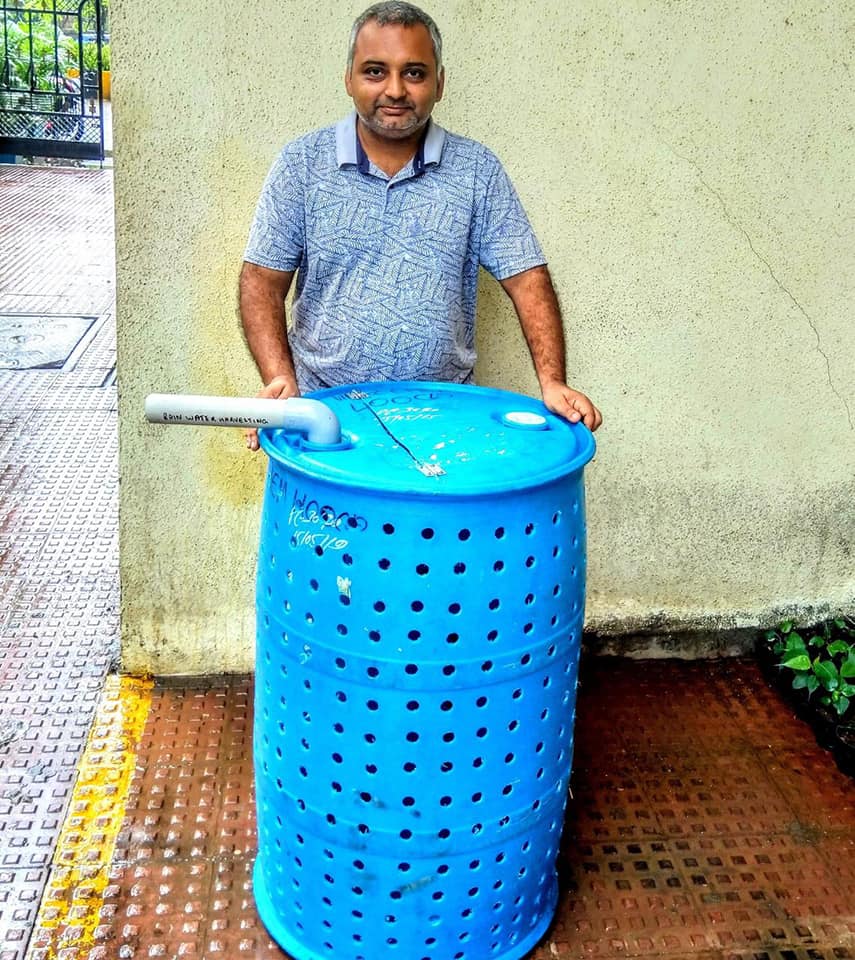Mumbai Man is Setting Up Low-Cost Rainwater Harvesting Systems in Schools!
Subhajit Mukherjee, the founder of city-based NGO, Mission Green Mumbai, has found a cost-effective solution to the problem of rainwater wastage using PVC pipes and a water drum.

During the incessant rains that paralysed the city on 1 July this year, the Brihanmumbai Municipal Corporation of Greater Mumbai flushed out more than 13,694 million litres of rainwater into the sea. This is equivalent to the combined water capacity of Tulsi lake at 4,385 ml and Vihar lake at 9,924 ml that supply potable water to Mumbai.
At a time when several cities across the country are running dry, it is indeed unfortunate that a city that has the potential to harvest rain has to release it into the sea. However, there are a few environmentally and socially proactive people who are not only changing their lifestyle but also innovating ways to conserve water.
If you want to save water right at home then there are many ways to do so. Check out these water saving devices at The Better India Shop today.
Subhajit Mukherjee, the founder of city-based NGO, Mission Green Mumbai, has found a cost-effective solution to the problem of rainwater wastage using PVC pipes and a water barrel/drum.

Thanks to the attention the solution has received, the Malad resident is now installing rainwater harvesting and groundwater recharging system in schools and private societies.
In an exclusive interview with The Better India (TBI), Mukherjee revealed that the idea was initially shared by retired IPS officer and governor of Puducherry, Kiran Bedi, almost a month ago.
“I spoke to her and researched further about how a system like this could be adopted. I got in touch with engineers at IIT Bombay who were able to help with the modifications required to make the system effective. Even they thought that the idea was cost-effective and wouldn’t require complex engineering knowledge to build. And, at the same time, it would give us immediate results.”
How does the system work?

The concept is straightforward. It channels water that falls onto your terrace into a pit underground to conserve and revive groundwater and other water bodies like ponds, lakes, and deep tube wells. It can be extracted for use too.
Mukherjee explains the different ways in which rainwater can be harvested.
One way is to dig a pit and create a catchment area to accumulate rainwater. Once dug, this pit is filled with small pebbles or stones to prevent evaporation. Once it starts raining, the rainwater falls into the pit through the crevices or gaps between the rocks and stones that cover it. Over some time, once full, this rainwater starts seeping into the ground, recharging the groundwater table.
Another advantage of adding these stones and pebbles is to avoid any pedestrian accidents. (e.g. since the pit is full of rocks, no passerby will fall into it).
Mukherjee’s second method gaining rapid popularity on social media involves a blue barrel and PVC pipes. This method is used not only to recharge groundwater but also to use the collected water for secondary purposes.
Take a barrel of the size and capacity you need and drill some holes around its surface.
Dig a 3×3 ft or 5×5 ft pit, install the drum in it and connect it with a PVC pipe leading to the terrace. Fill the cavity with pebbles and stones to prevent mud from entering the drum and wedge the drum firmly.
Benefits?
Mukherjee adds how the drum can hold water for seven to 10 days as it takes time for the water to seep entirely into the ground. He has suggested the institutes, who have installed the system, to use the harvested water to mop floors, water trees or clean toilets.
“Think about it, a school, on an average, needs at least 5,000 litres of water every month for floor mopping. Imagine saving 5,000 litres of rainwater every month during the monsoon season. This accounts for saving close to 20,000 litres of water for cleaning and mopping over four months.”
Also, if installed in societies, this water can be used for the secondary purpose of washing vehicles, adds Mukherjee.
“There are more than 18 lakh vehicles in the city. If we use five litres of water to clean one vehicle, imagine the lakhs of litres of water that is being wasted. This harvested rainwater can be used to tackle that wastage or even mop common spaces within societies.”
While installing these units, one must remember to keep them at least 10 to 20 feet away from the main building to prevent the water from seeping into the building walls and making them weak.
After getting more than a thousand calls, Mukherjee has created a video which explains the entire process of installing the system. Watch it below:
Shedding light on the time taken to set up the system, he says, “It takes no more than two to three hours depending on the size of the pit and the labour available. In a school, with the help of 100-200 students, we can do it within two hours.”
He has executed the project is more than 33 schools in the last month, working with almost 20,000+ students. He aims to scale this number up to 100 schools soon.
“The kids have a lot of fun doing it. They play and learn as they dig the ground and collect pebbles and stones to add to the pit. Our focus is on schools to increase awareness. Kids are the best medium to bring about this change. I want to especially thank all the principals of the schools who have displayed unwavering support for the project. The kids proudly tell their parents about how they built this pit. We are hoping it will motivate their colonies and societies to do it too.”
You May Also Like: Rajasthan Makes Planting Trees, Digging Ponds Compulsory For Engineering Students!
The cost for the entire installation can range between Rs 2,500 to 5,000 based on the availability of resources and labour required, in a lot of spaces where drums and pipes are available, it is done for free, says Mukherjee.

“But when we are installing these pits in schools, I do involve some labour, because I don’t want children to pick up the drum. Sometimes, when the school doesn’t have a drum, I shell money from my pocket,” he says.
In a final message to citizens, Mukherjee says, “It is indeed unfortunate that we have huge towers in the city, but we fail to do something as simple as harvest rainwater every monsoon, that too in a place where it rains abundantly. As humans, water is the first element we are exposed to, like in the womb of our mothers. How can we not work towards conserving it? We need to conserve water in order to consume it. This system is easy to install and is much like creating a mini-well. We need to take ownership of the quality of life that we deserve. This is one way of doing it.”
If this story inspired you and you want to join Subhajit Mukherjee on his mission, write to him at [email protected]
Photo Credits: Subhajit Mukherjee
(Edited by Saiqua Sultan)
Like this story? Or have something to share?
Write to us: [email protected]
Connect with us on Facebook and Twitter.
This story made me
- 97
- 121
- 89
- 167
Tell Us More
We bring stories straight from the heart of India, to inspire millions and create a wave of impact. Our positive movement is growing bigger everyday, and we would love for you to join it.
Please contribute whatever you can, every little penny helps our team in bringing you more stories that support dreams and spread hope.



















